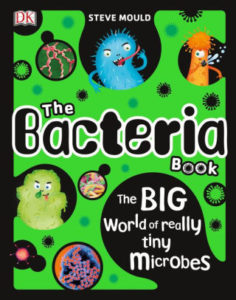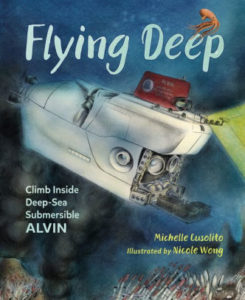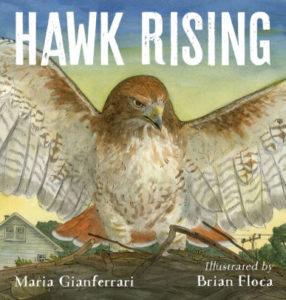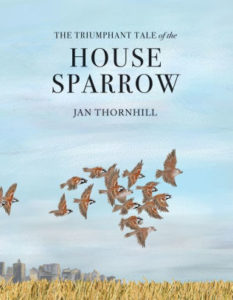Four new science picture books entertain while informing young readers about microbes, sparrows, hawks, and deep-sea exploration. Ages 6-10
The Bacteria Book: the BIG World of Really Tiny Microbes by Steve Mould. DK, 2018, 71 pages including index.
The “yuck” factor is always in play when learning about the bacterial world, especially when it comes to highly magnified photos of what they really look like. Especially on your skin or on your eyelashes. This book manages to include enough facts along with the grossness to make it worthwhile. The main title is a bit of a misnomer, as the content begins with “What is a Microbe?” and goes on to discuss not only bacteria, but also viruses, fungi, algae, protozoa, and archaea. That’s a lot to cover, along with such penumbra as cell replication, DNA, microscope technology, and germ theory. Fortunately the book holds up through several browsings. The scrapbook-style arrangement works well here, though: each double-page spread addresses some aspect of the microbe under examination, with generally one sidebar and one or two text boxes. Illustrations are solid-form cartoons supplemented by photos. A generally pleasing and effective introduction to the micro world. For ages 6-10
Cautions: Two references to evolution and billions of years of development.
Flying Deep: Climb Inside a Deep-Sea Submersible ALVIN by Michelle Cusolito, Illustrated by Nicole Wong. Charlesbridge 2018, 32 pages 
You’ve met ALVIN if you know anything about the Titanic (or saw the movie). There have actually been seven ALVIN’s, from 1964 until now, each a little more amazing and productive than the last. This informational picture book imagines a deep-sea dive into the Pacific to examine the remains of a volcanic eruption and bring back samples of ocean-floor life. Down we go as the water shades from clear to aqua to indigo and finally to blackest black. “Cottony fields of bacteria wave in currents . . . Pompeii worms, like sausages sporting dreadlocks, move in and out of tubes.” After exercising the robotic arms and trapping animal and plant life in the external cages, back we go to the mother ship. But kids will be fascinated enough to demand a return visit. Two miles below the surface, it truly is another world, one that most humans will never see. If the kids are old and receptive enough it’s worth asking the question, How do these hidden things glorify God? For ages 6-10
Hawk Rising by Maria Gianferraro, illustrated by Brian Flocca. Roaring Brook, 2018, 40 pages.
Early in the morning, a red-tailed hawk stretches his neck, lifts his wings and rises from the nest where his mate keeps their three chicks warm. Soon after, “High above your house Father Hawk circles, his sharp eyes searching for prey.” Those hungry chicks demand to be fed, but unless he’s watchful and quick, they won’t eat today. His first dive fails; the little chipmunk gets away, and the reader sighs with relief. But other cute furry animals are running around down there and—spoiler alert!—the hawk will get one. Very sensitive young readers might be advised to leave this one alone, but the beautiful illustrations and evocative text make a springboard for older readers to think about the balance of nature and why God designed some animals to eat other animals. Is this a good thing? For ages 6-10
Cautions: Disturbing images (not graphic, but “nature red in tooth and claw”)
The Triumphant Tale of the House Sparrow by Jan Thornhill. Groundwood Books, 2018, 44 pages.
Those black-bibbed little birds with bulky beaks and sporty white bands were once despised and almost obliterated. The sparrow’s story begins as far back as recorded time, when they began to flourish, along with humans, in the fertile crescent and Nile river valleys. Humans planted grain, and sparrows ate it—a beautiful relationship until the little birds multiplied enough to be a threat. Thereafter, wherever humans have gone the sparrows weren’t far behind. Whatever the challenge, whether flood or famine or bounties places on their little heads, they multiplied right up until the 20th century, when paved roads began to replace dirt ones, and bird-proof grain silos dotted the landscape. But, as the narrative makes plain, sparrows are among the most adaptable creatures on earth, and they’re making a comeback. This either a heavily illustrated text or a text-heavy picture book, but the balance seems perfect. The Triumphant Tale is a beautiful example of humans and animals not just coexisting, but complementing each other. For ages 6-10 as a read-aloud; 8-10 as independent readers.
Support our writers and help keep Redeemed Reader ad-free by joining the Redeemed Reader Fellowship.
Stay Up to Date!
Get the information you need to make wise choices about books for your children and teens.
Our weekly newsletter includes our latest reviews, related links from around the web, a featured book list, book trivia, and more. We never sell your information. You may unsubscribe at any time.
We'd love to hear from you!
Our comments are now limited to our members (both Silver and Golden Key). Members, you just need to log in with your normal log-in credentials!
Not a member yet? You can join the Silver Key ($2.99/month) for a free 2-week trial. Cancel at any time. Find out more about membership here.

